Abstract
This paper outlines our knowledge of the reaction of organophosphorus compounds and carbamates with esterases, examples of particular aspects of the reaction being confined to cholinesterases, although the general principles discussed apply to all B-esterases. Mathematical expressions are given for the different rate constants, and some of the factors that may affect the response of insect and mammalian cholinesterases to organophosphorus compounds and carbamates are discussed.
Full text
PDF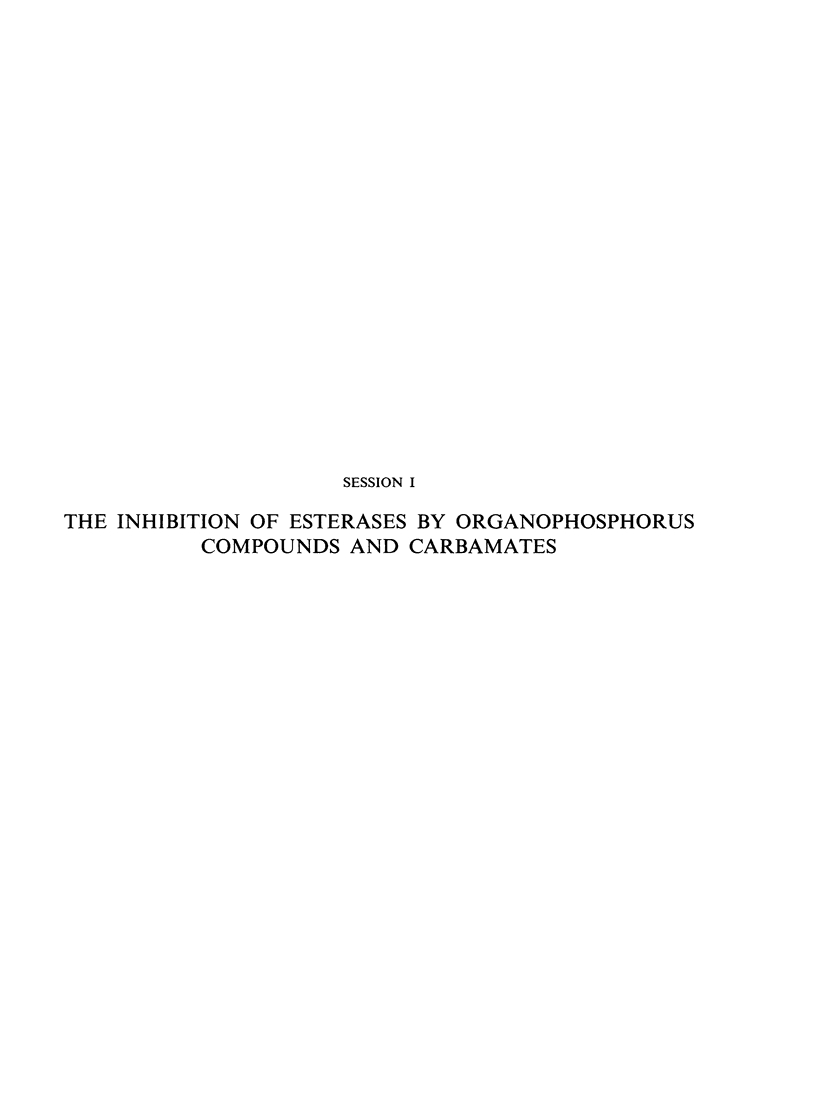
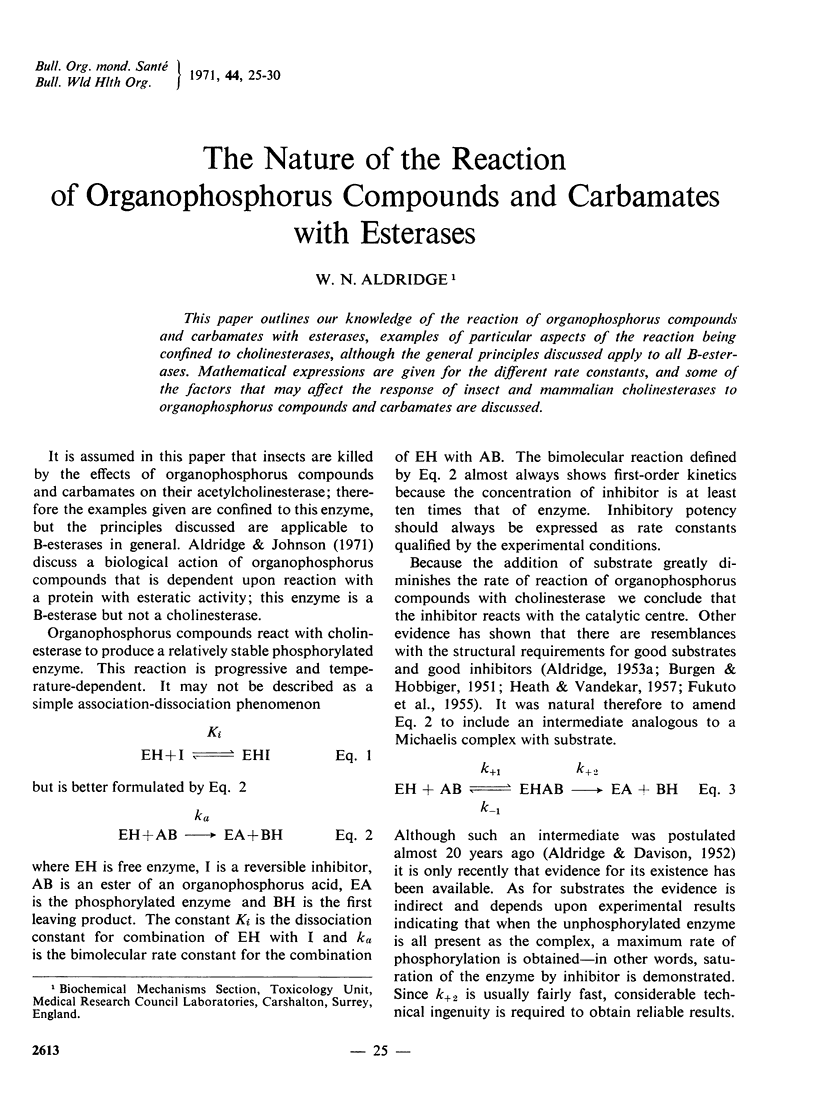
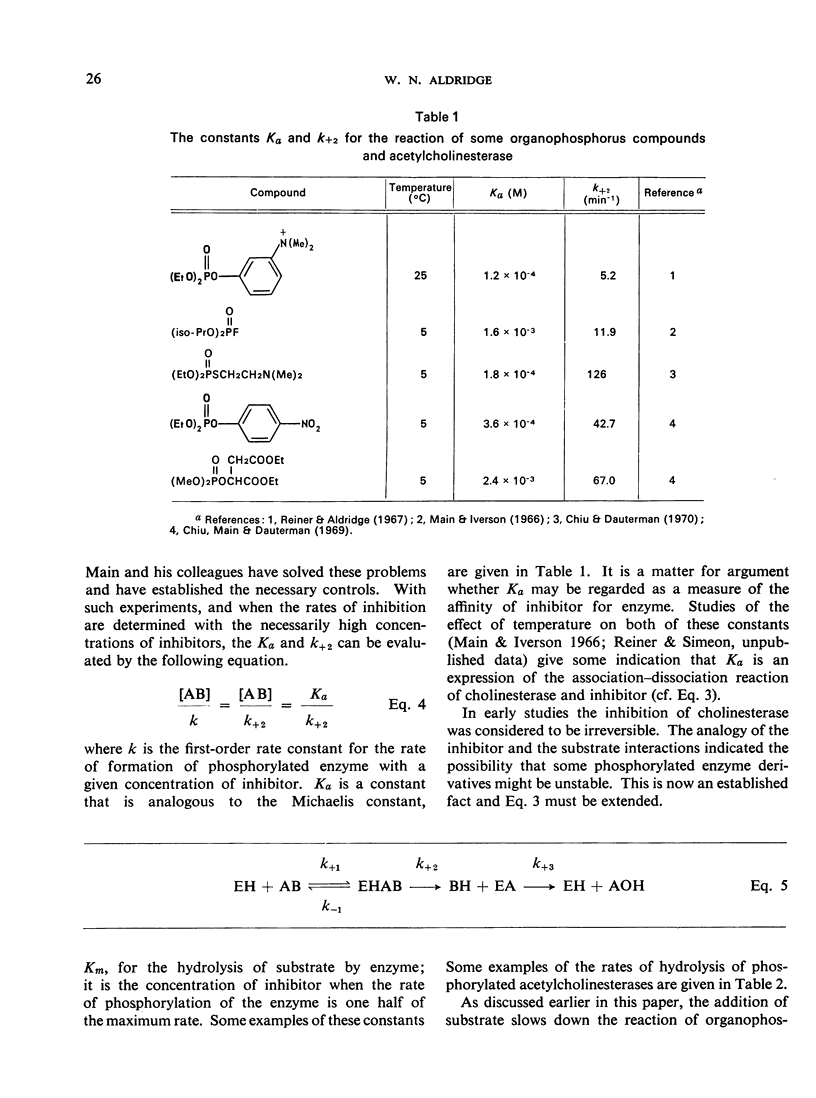
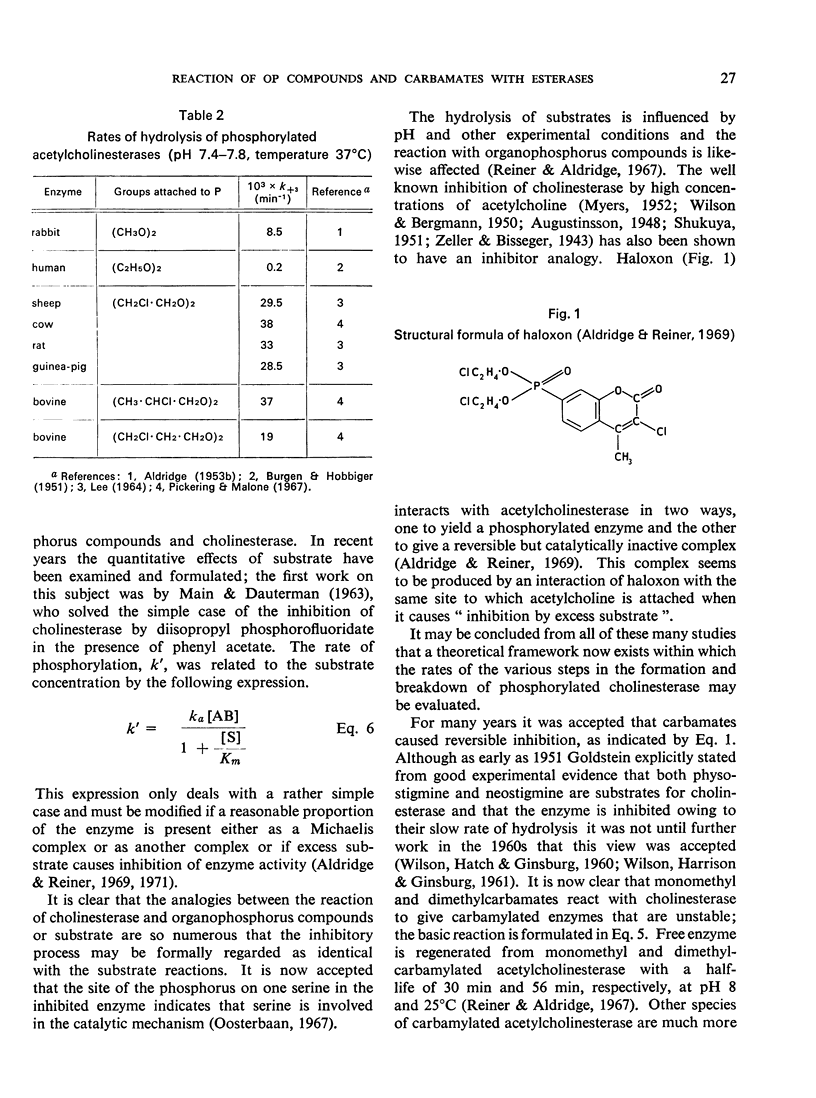
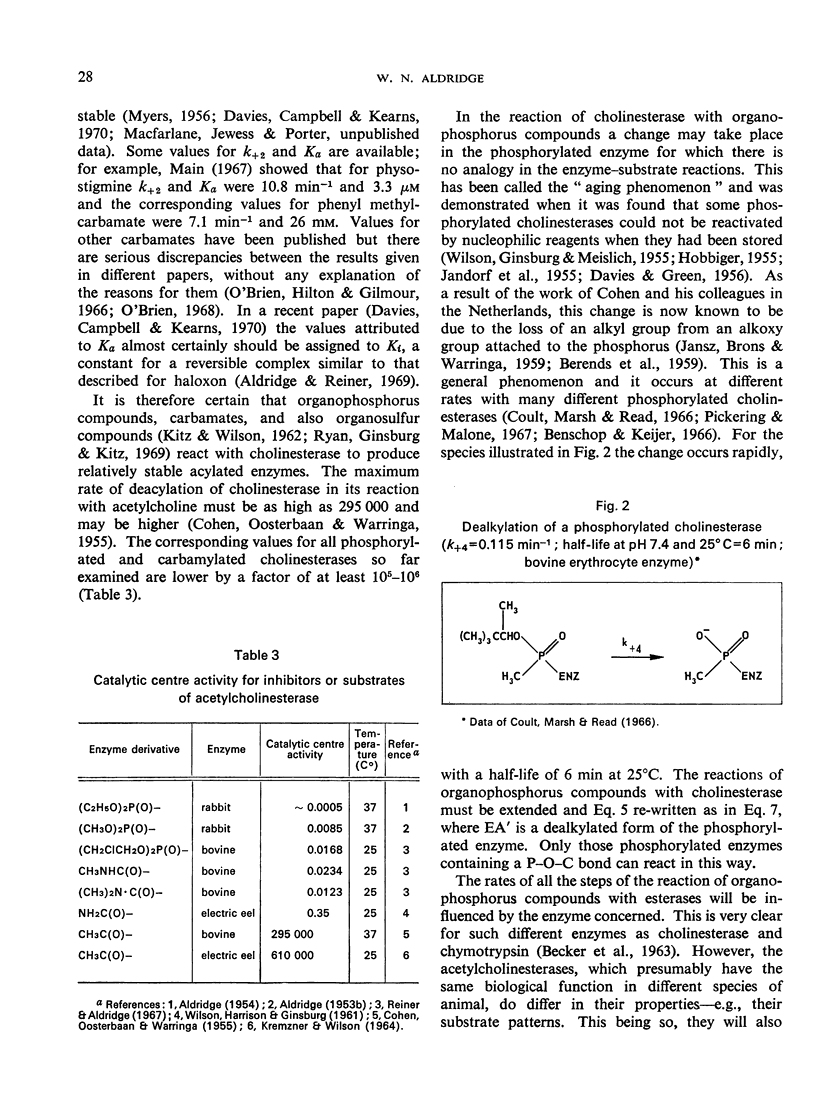
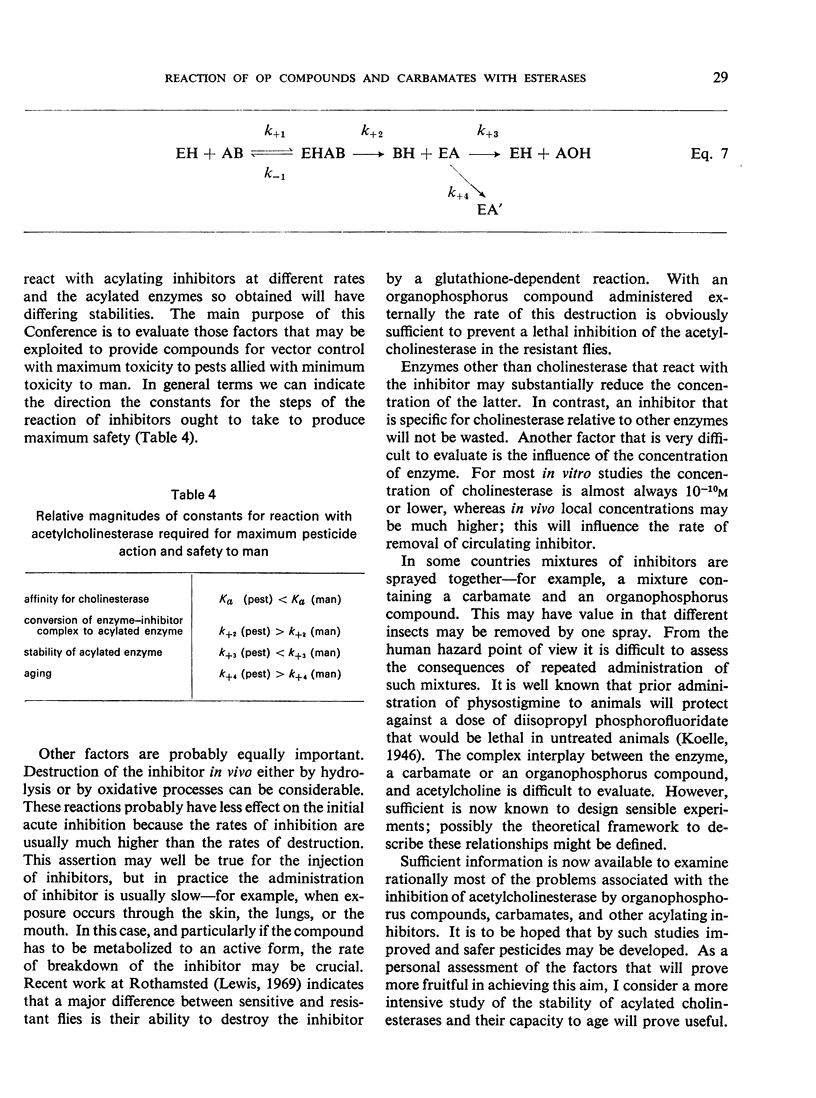
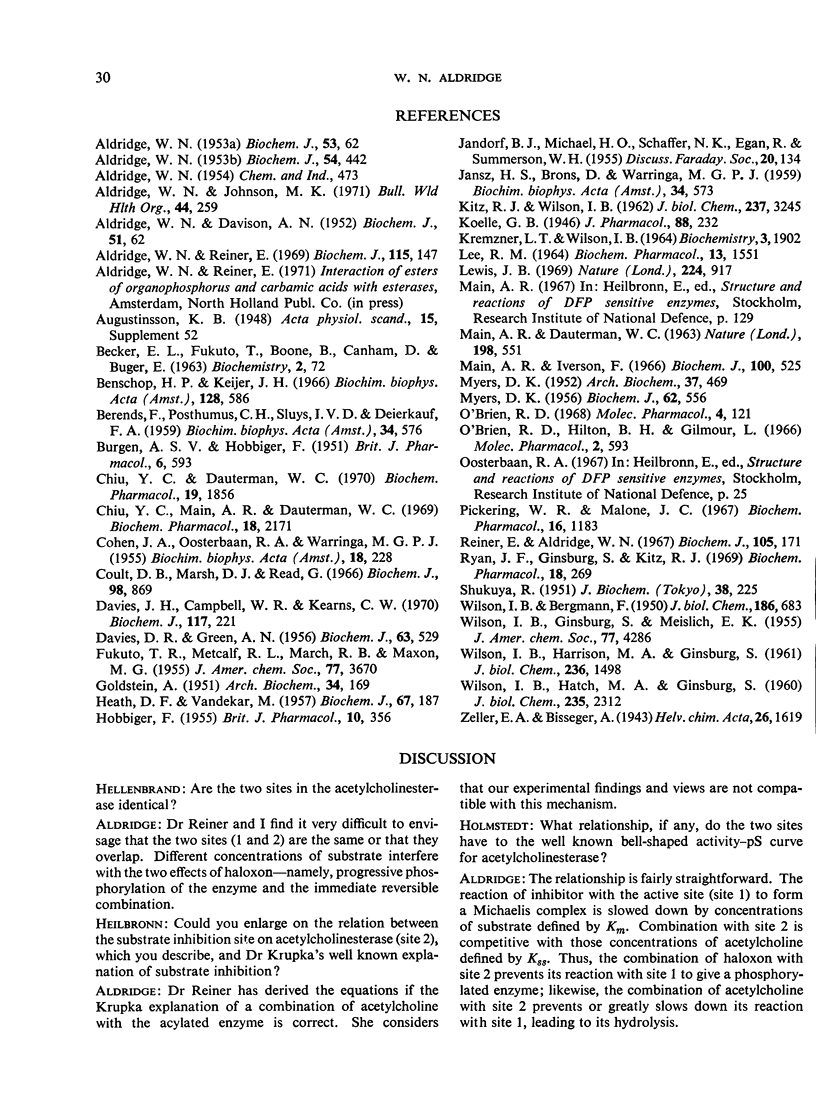
Selected References
These references are in PubMed. This may not be the complete list of references from this article.
- ALDRIDGE W. N., DAVISON A. N. The inhibition of erythrocyte cholinesterase by tri-esters of phosphoric acid. I. Diethyl p nitrophenyl phosphate (E600) and analogues. Biochem J. 1952 Apr;51(1):62–70. doi: 10.1042/bj0510062. [DOI] [PMC free article] [PubMed] [Google Scholar]
- ALDRIDGE W. N. The differentiation of true and pseudo cholinesterase by organophosphorus compounds. Biochem J. 1953 Jan;53(1):62–67. doi: 10.1042/bj0530062. [DOI] [PMC free article] [PubMed] [Google Scholar]
- ALDRIDGE W. N. [The inhibition of erythrocyte cholinesterase by tri-esters of phosphoric acid. III. The nature of the inhibitory process]. Biochem J. 1953 Jun;54(3):442–448. doi: 10.1042/bj0540442. [DOI] [PMC free article] [PubMed] [Google Scholar]
- Aldridge W. N., Johnson M. K. Side effects of organophosphorus compounds: delayed neurotoxicity. Bull World Health Organ. 1971;44(1-3):259–263. [PMC free article] [PubMed] [Google Scholar]
- Aldridge W. N., Reiner E. Acetylcholinesterase. Two types of inhibition by an organophosphorus compound: one the formation of phosphorylated enzyme and the other analogous to inhibition by substrate. Biochem J. 1969 Nov;115(2):147–162. doi: 10.1042/bj1150147. [DOI] [PMC free article] [PubMed] [Google Scholar]
- BECKER E. L., FUKUTO T. R., BOONE B., CANHAM D. C., BOGER E. The relationship of enzyme inhibitory activity to the structure of n-alkylphosphonate and phenylalkyl-phosphonate esters. Biochemistry. 1963 Jan-Feb;2:72–76. doi: 10.1021/bi00901a014. [DOI] [PubMed] [Google Scholar]
- BURGEN A. S. V., HOBBIGER F. The inhibition of cholinesterases by alkyl-phosphates and alkylphenolphosphates. Br J Pharmacol Chemother. 1951 Dec;6(4):593–605. doi: 10.1111/j.1476-5381.1951.tb00670.x. [DOI] [PMC free article] [PubMed] [Google Scholar]
- COHEN J. A., OOSTERBAAN R. A., WARRINGA M. G. The turnover number of aliesterase, pseudo- and true cholinesterase and the combination of these enzymes with diisopropylfluorophosphonate. Biochim Biophys Acta. 1955 Oct;18(2):228–235. doi: 10.1016/0006-3002(55)90060-3. [DOI] [PubMed] [Google Scholar]
- Chiu Y. C., Dauterman W. C. Effect of tetraethylammonium ions on the affinity and phosphorylation or carbamylation constants of malaoxon, Tetram and Temik with acetylcholinesterase. Biochem Pharmacol. 1970 May;19(5):1856–1857. doi: 10.1016/0006-2952(70)90187-5. [DOI] [PubMed] [Google Scholar]
- Chiu Y. C., Main A. R., Dauterman W. C. Affinity and phosphorylation constants of a series of O,O-dialkyl malaoxons and paraoxons with acetylcholinesterase. Biochem Pharmacol. 1969 Sep;18(9):2171–2177. doi: 10.1016/0006-2952(69)90322-0. [DOI] [PubMed] [Google Scholar]
- Coult D. B., Marsh D. J., Read G. Dealkylation studies on inhibited acetylcholinesterase. Biochem J. 1966 Mar;98(3):869–873. doi: 10.1042/bj0980869. [DOI] [PMC free article] [PubMed] [Google Scholar]
- DAVIES D. R., GREEN A. L. The kinetics of reactivation, by oximes, of cholinesterase inhibited by organophosphorus compounds. Biochem J. 1956 Aug;63(4):529–535. doi: 10.1042/bj0630529. [DOI] [PMC free article] [PubMed] [Google Scholar]
- Davies J. H., Campbell W. R., Kearns C. W. Inhibition of fly head acetylcholinesterase by bis-[(m-hydroxyphenyl)-trimethylammonium iodide] esters of polymethylenedicarbamic acids. Biochem J. 1970 Apr;117(2):221–230. doi: 10.1042/bj1170221. [DOI] [PMC free article] [PubMed] [Google Scholar]
- GOLDSTEIN A. Properties and behavior of purified human plasma cholinesterase. III. Competitive inhibition by prostigmine and other alkaloids with special reference to differences in kinetic behavior. Arch Biochem Biophys. 1951 Nov;34(1):169–188. doi: 10.1016/s0003-9861(51)80023-7. [DOI] [PubMed] [Google Scholar]
- HEATH D. F., VANDEKAR M. Some spontaneous reactions of 00-dimethyl S-ethylthioethyl phosphorothiolate and related compounds in water and on storage, and their effects on the toxicological properties of the compounds. Biochem J. 1957 Oct;67(2):187–201. doi: 10.1042/bj0670187. [DOI] [PMC free article] [PubMed] [Google Scholar]
- HOBBIGER F. Effect of nicotinhydroxamic acid methiodide on human plasma cholinesterase inhibited by organophosphates containing a dialkylphosphato group. Br J Pharmacol Chemother. 1955 Sep;10(3):356–362. doi: 10.1111/j.1476-5381.1955.tb00884.x. [DOI] [PMC free article] [PubMed] [Google Scholar]
- JANSZ H. S., BRONS D., WARRINGA M. G. Chemical nature of the DFP-binding site of pseudocholinesterase. Biochim Biophys Acta. 1959 Aug;34:573–575. doi: 10.1016/0006-3002(59)90320-8. [DOI] [PubMed] [Google Scholar]
- KITZ R., WILSON I. B. Esters of methanesulfonic acid as irreversible inhibitors of acetylcholinesterase. J Biol Chem. 1962 Oct;237:3245–3249. [PubMed] [Google Scholar]
- KREMZNER L. T., WILSON I. B. A PARTIAL CHARACTERIZATION OF ACETYLCHOLINESTERASE. Biochemistry. 1964 Dec;3:1902–1905. doi: 10.1021/bi00900a020. [DOI] [PubMed] [Google Scholar]
- LEE R. M. DI-(2-CHLOROETHYL) ARYL PHOSPHATES. A STUDY OF THEIR REACTION WITH B-ESTERASES, AND OF THE GENETIC CONTROL OF THEIR HYDROLYSIS IN SHEEP. Biochem Pharmacol. 1964 Dec;13:1551–1568. doi: 10.1016/0006-2952(64)90210-2. [DOI] [PubMed] [Google Scholar]
- Lewis J. B. Detoxification of diazinon by subcellular fractions of diazinon-resistant and susceptible houseflies. Nature. 1969 Nov 29;224(5222):917–918. doi: 10.1038/224917a0. [DOI] [PubMed] [Google Scholar]
- MYERS D. K. Effect of salt on the hydrolysis of acetylcholine by cholinesterases. Arch Biochem Biophys. 1952 Jun;37(2):469–487. doi: 10.1016/0003-9861(52)90208-7. [DOI] [PubMed] [Google Scholar]
- MYERS D. K. Studies on cholinesterase. 10. Return of cholinesterase activity in the rat after inhibition by carbamoyl fluorides. Biochem J. 1956 Apr;62(4):556–563. doi: 10.1042/bj0620556. [DOI] [PMC free article] [PubMed] [Google Scholar]
- Main A. R., Iverson F. Measurement of the affinity and phosphorylation constants governing irreversible inhibition of cholinesterases by di-isopropyl phosphorofluoridate. Biochem J. 1966 Aug;100(2):525–531. doi: 10.1042/bj1000525. [DOI] [PMC free article] [PubMed] [Google Scholar]
- O'Brien R. D., Hilton B. D., Gilmour L. The reaction of carbamates with cholinesterase. Mol Pharmacol. 1966 Nov;2(6):593–605. [PubMed] [Google Scholar]
- O'Brien R. D. Kinetics of the carbamylation of cholinesterase. Mol Pharmacol. 1968 Mar;4(2):121–130. [PubMed] [Google Scholar]
- Pickering W. R., Malone J. C. The acute toxicity of dichloroalkyl aryl phosphates in relation to chemical structure. Biochem Pharmacol. 1967 Jul 7;16(7):1183–1194. doi: 10.1016/0006-2952(67)90150-5. [DOI] [PubMed] [Google Scholar]
- Reiner E., Aldridge W. N. Effect of pH on inhibition and spontaneous reactivation of acetylcholinesterase treated with esters of phosphorus acids and of carbamic acids. Biochem J. 1967 Oct;105(1):171–179. doi: 10.1042/bj1050171. [DOI] [PMC free article] [PubMed] [Google Scholar]
- Ryan J. F., Ginsburg S., Kitz R. J. The reaction of acetylcholinesterase with methanesulfonyl esters of quaternary quinolinium compounds. Biochem Pharmacol. 1969 Feb;18(2):269–278. doi: 10.1016/0006-2952(69)90204-4. [DOI] [PubMed] [Google Scholar]
- WILSON I. B., BERGMANN F. Acetylcholinesterase. VIII. Dissociation constants of the active groups. J Biol Chem. 1950 Oct;186(2):683–692. [PubMed] [Google Scholar]
- WILSON I. B., HARRISON M. A., GINSBURG S. Carbamyl derivatives of acetylcholinesterase. J Biol Chem. 1961 May;236:1498–1500. [PubMed] [Google Scholar]
- WILSON I. B., HATCH M. A., GINSBURG S. Carbamylation of acetvlcholinesterase. J Biol Chem. 1960 Aug;235:2312–2315. [PubMed] [Google Scholar]


